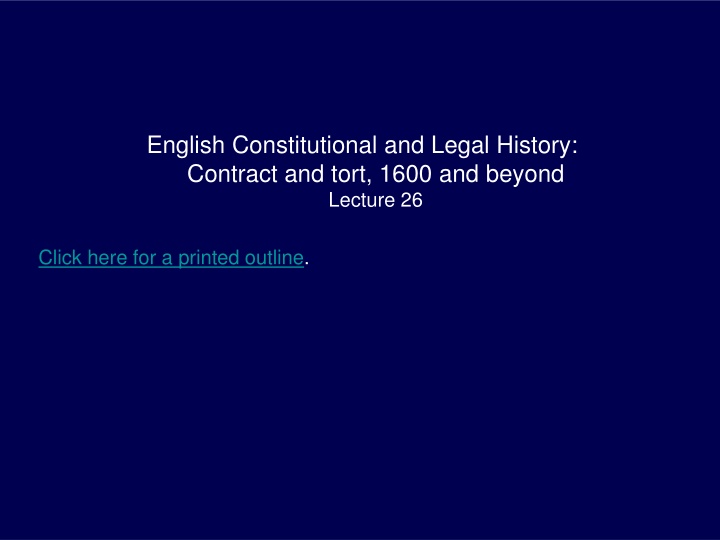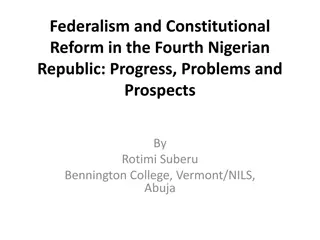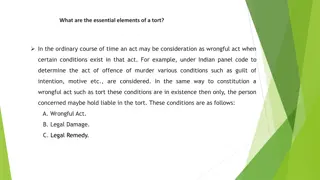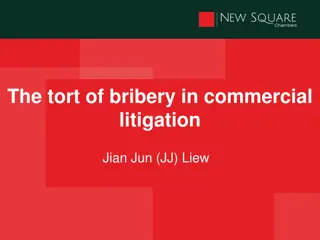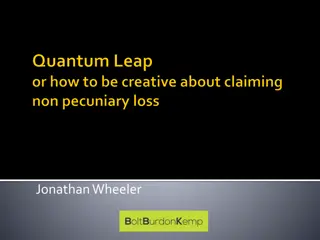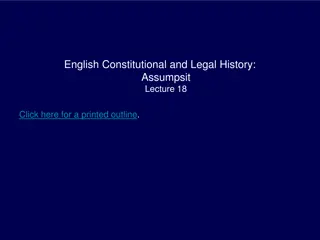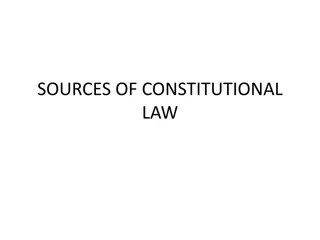English Constitutional and Legal History: Contract and tort, 1600 and beyond Lecture 26
Delve into the evolution of contract and tort law in English constitutional and legal history, exploring significant developments post-1600. Gain insights into key aspects of contractual and tortuous relations, shaping modern legal frameworks.
Download Presentation

Please find below an Image/Link to download the presentation.
The content on the website is provided AS IS for your information and personal use only. It may not be sold, licensed, or shared on other websites without obtaining consent from the author.If you encounter any issues during the download, it is possible that the publisher has removed the file from their server.
You are allowed to download the files provided on this website for personal or commercial use, subject to the condition that they are used lawfully. All files are the property of their respective owners.
The content on the website is provided AS IS for your information and personal use only. It may not be sold, licensed, or shared on other websites without obtaining consent from the author.
E N D
Presentation Transcript
English Constitutional and Legal History: Contract and tort, 1600 and beyond Lecture 26 Click here for a printed outline.
Introduction Pur avoider le stuffing del rolls ove multip Let us look at developments in the personal actions, contract and tort, from the point of view of the year 1600. In both cases the question is where have we been and where do we go from here? For the law students this is largely a question of how do we get to where we are today. For the FAS students it is more a question of what was the potential of the system in 1600. Both points of view are valid, and both have their dangers. The danger of the law students point a view is the old bugaboo of lawyers legal history, seeing the present in the past far too early. The danger of the FAS students point of view is that we are likely to get so mired in the past that we don t see the dynamic potential of the system by the time we reach our ending point.
Contract in general No place are these parallel dangers more present than in the history of the law of contract. It s obviously important by 1600. It will became even more important as England continues to expand first commercially and then industrially. It became something of a fetish in the 19th century when the common law of contract was associated with economic liberalism. It is rather out of favor today with the decline of economic liberalism, but as one might expect, it is favored by the law and economics movement, the inheritors of 19th century liberalism.
Contract in general (contd) Let me give you an idealized version of contract, created in the 19th century and carrying well on into the 20th. Contract is about the enforcement of promises. Not all promises will be enforced, only those supported by consideration. The paradigm contract is the one in which a promise is exchanged for a promise. The mutual promises are consideration for each other. You promise to pay me a certain price for 40 quarters of no. ten red wheat, and I promise to deliver the wheat to you. But contract is not only about buying and selling, it is about all forms of human relationships. Everything except, perhaps, the law of wrongs can be encompassed in the notion of contract. The way in which things that are not normally thought of as promises are encompassed in the idea of contract is by implying promises where none were expressly made, in order, for example, to allow recovery of the fair market value of goods sold where the parties failed to specify a price or in order to recover mistaken payments. This is sometimes called quasi-contract. Contract then becomes the means by which the law allows people to realize themselves through the exercise of their wills. When did English law see things that way?.
Contract in general (contd) It has recently been pointed out that a theory of contract that sees in the institution a realization of human will is probably not likely to be found much before the German idealists, Kant in the late 18th century and particularly Hegel in the early 19th century, with their heavy emphasis on the will as the ultimate concern of human governance and morality. The same may be said of the notion also popularized in the 19th century and sometimes made a part of the will theory, that contract is necessary in order to have markets operate efficiently. It is highly unlikely that anyone would have thought that was a value much before Adam Smith, and Adam Smith published The Wealth of Nations in 1776. This is not to say that we don t see anticipations of both of these ideas in early modern, indeed in medieval, authors, but none would have focused on them in quite the way that the 19th century did.
Contract in general (contd) The question then becomes a somewhat different one, when did the law first develop a unitary notion of contract to which such theories could attach themselves, for which they might in some way provide a justification? No one would argue that it happened in the Middle Ages. The split between debt and covenant saw to it that it could not happen. But when debt and covenant were merged in a new action of assumpsit, it is possible that a unitary idea of contract emerged. It is also possible that it did not. Just because you have form of action doesn t mean that you have a one overarching idea. Let us look at the situation around 1600 to see whether the idea is there or not.
Slades Case (1602) We last left contract at Slade s Case (1602). The case came to the old Exchequer Chamber as a result of the competition between KB and CP in the 16th century and the introduction of the statutory Exchequer Chamber in the reign of Elizabeth I. KB had allowed an action on the case in assumpsit to substitute for debt; CP had basically refused to do so. Coke s report of the case was quite tendentious. His report offers six resolutions that were reached in the case. It is not at all clear that all of them were, and for a while the CP justices objected to the report, but they decided to go along with it in the 1610s. Here are Coke s six resolutions as interpreted by Baker (see Mats., pp. VII 51 to VII 52):.
Slades Case (1602): Cokes six resolutions You can bring assumpsit even if debt is available, the authority for this is other cases of duplication, e.g., assumpsit for covenant, trover for detinue, case for nuisance. (Resolutions nos. 1 2, p. VII 51 to VII 52, also Resolution no. 6, p. VII 52.) Every contract executory imports in itself an assumpsit. What this means is that what we would call a partially executed contract, a contract that has been performed on one side but not on the other contains within it an implied assumpsit, an undertaking, by the benefited person to pay what has been promised for benefits that he has received. (Resolution no. 3, p. VII 52.) If only the debt (as opposed to special damages) is sued for, the damages will be the same in either case (Resolution no. 4, p. VII 52) hence one action will bar the other (that may not be a resolution of Slade s Case, but it is never again doubted) hence debt on a contract is dead debt on an obligation continued.
Slades Case (1602): Cokes six resolutions Resolution no. 5 (p. VII 52) has to do with the problem of serial deliveries and special damages. It need not concern us here.
Slades Case (1602): what was not covered Problem of consideration not really considered by 1612 the fictional promise has an equally fictional consideration there is nothing in this case about a promise being a consideration for a promise. Doesn t say anything about quasi-contract. No discussion of indebitatus assumpsit ( having been indebted he undertook ) because that was not what was pleaded and the contract was laid out quite specifically and so proven. General declarations not involved the subsequent distinction between general and special assumpsit. Problems: Wager of law wasn t all that bad. The problem of the general pleading in assumpsit. .
Developments after Slades Case and related to that case Slade s Case and the problem of indefinite pleading. indebitatus assumpsit not enough notice the common counts: goods sold and delivered, goods bargained and sold, work done, money lent, money spent by plaintiff to defendant s use, money had and received by defendant to plaintiff s use, and money due on an account stated Slade s Case and the problem of perjury >the Statute of Frauds a remarkable effort of the late 17th century involving both Lord Nottingham (LC, 1675 1682) and Lord North (CJCP, 1675 1682), return of wager of law arguments, limitation of damages suggested (cf. continental parallels (legislation of Louis XIV)), the ultimate resolution is the Statute of Frauds, requiring a writing but not a seal for most important kinds of contracts, including sales cases where a substantial amount was at stake.
Developments after Slades Case: quasi-contract counts in quantum meruit (how much he deserved) and quantum valebat (how much it was worth) rapidly became fictional. fictional insumul computasset was used to recover debts where the existence of a debt had had been acknowledged by the defendant even though no accounting in the traditional sense had taken place money had and received was used for mistaken payments, but Lord Holt (CJKB, 1689 1710) stopped most further developments on this count assumpsit for use and occupation becomes a kind of quantum valebat in the situation where there was a lease that either failed to specify the rent or was unenforceable under the Statute of Frauds, never allowed to substitute for ejectment money had and received in a rescission context develops after Holt s time waiver of tort and suit in assumpsit (again money had and received), even Holt accepts this in the context of a tortious sale
Developments after Slades Case: quasi-contract (contd) fictitious money had and received also allowed for certain contribution situations, e.g., among co-sureties. Curiously in England the restitutionary actions died with the forms of action only to be revived quite recently. What happens in the 17th and 18th centuries has analogies to the Statute of Uses; people ask what could have been brought in debt prior to Slade s Case, even though there is little evidence that these things ever were brought in debt. The details are contained in the cases on pp. IX 148 to IX 162 (in sec. 9G of the Mats.). I don t think we need to go into it. I would suggest that the key historical issue is what was going on with C.J. Holt, and I would also suggest that we still don t know.
Developments before and after Slades Case and unrelated to that case In the 16th century both KB and CP agreed that in order to found an action in assumpsit, the undertaking had to be supported by something called consideration . The discussions of what consideration is are quite murky in both courts. It seems to be a merger or a blend of the quid pro quo that was required in actions of debt or detinue, a notion that an action taken in reliance on a promise was a sufficient consideration to found an action on the undertaking, and the Continental civilian causa contrahendi, the notion that causeless promises will not be judicially enforced. The first clear cases that hold that a counter-promise is sufficient consideration to found an assumpsit on the initial undertaking do not come until shortly after Slade s Case. But there are cases quite a bit before Slade s Case that pretty clearly imply it. In the process of developing the doctrine of consideration one of the civilian causes for enforcing a promise got left out, the cause of a promise to make a gift. (cont d)
Developments before and after Slades Case (contd) (cont d) That remains to this day one of the few differences, between the Continental civil law of contract and the Anglo-American law of contract. In the 16th and 17th centuries, a promise to make a gift had to be under seal in order for it to be enforceable, and that may still be the law today in the U.S. Merger of warranty into the assumpsit action is a development just hinted at the end of 17th c. (origins, as we have seen, in the action on the case for deceit). Contract as we know it, offer and acceptance, covenants and conditions, general and special damages, total breach and anticipatory breach is largely the creation of the late 18th and 19th centuries. The importance of Lord Mansfield and Continental law.
Developments before and after Slades Case (contd) Is the will theory of contract of contract the invention of 19th century liberalism? Patrick Atiyah thinks so. Baker has more doubts. In the case of both Atiyah and Morton Horwitz for the U.S. both authors may put too much emphasis on the relatively few cases in which courts in our period were willing to examine into the worth of consideration. Leaving that mistake aside, the fact is that the number of reported cases of special assumpsit prior to Lord Mansfield is very small. The medieval idea of contract died hard, and if the current developments, along the lines of Grant Gilmore s Death of Contract are any indication, are any indication, it may not be dead yet. Totally apart from the theoretical considerations in Gilmore, it is striking how few breach of contract cases are brought today where the contract is totally in the executory stage. Almost always there has been partial performance or detrimental reliance.
Torts in general As in the case of contract so too in the case of the law of wrongs, the problem is seeing how much of the 19th century settlement was already there in 1600. Unlike the case of contract, there is a large measure agreement among historians today that not very much of 19th settlement can be seen in 1600. Now that should be surprising to you, because in fact we ve seen a number of pieces of the modern and 19th century law of tort already, and by the time we get to end of the 17th century almost all of the pieces will be there. The 19th century settlement is largely the product of two men, Holmes in the United States and Pollock in England. It sees the law of wrongs as basically divided into the three parts:
Torts in general (contd) Intentional torts. Assault and battery is the classic example, and the equally classic illustration is a punch in the nose. But we may generalize and say that any intentional infliction of harm by the defendant on the plaintiff to which the plaintiff did not consent (to exclude surgery and boxing matches) will be actionable. The sphere of plaintiff s interests protected by the action was still uncertain in the 19th century. It certainly included his person, and both his land and chattels. Whether it also included incorporeal harms, like the infliction of emotional distress, is less clear. On the other hand, telling a falsehood about someone that damages his reputation will be actionable. The law of libel and slander, as we have seen, is very old, though the details of our law are quite modern.
Torts in general (contd) Torts based on negligent infliction of physical harm. Negligence is an elastic concept, but in the 19th century it is becoming clear that it means the failure of the defendant to take care when a reasonably prudent person would have taken care to avoid the injury. Horse and coach accidents are the classic example, just like automobile accidents are the classic example in the 20th century. Each wave of new technology brings a reevaluation of notions of standards of care. Strict or absolute liability. Holmes s views on this branch of the law are controversial. My colleague David Rosenberg has written a book arguing that Holmes thought that this branch was an acceptable one for industrial activity generally. Pollock clearly thought that it should be limited to certain kinds of ultrahazardous activities, like using dynamite.
Torts in general (contd) Just as in the case of contracts, it is clear that no one said what I have just said before the 19th century. We do not even have, as we do in the case of contract, a single form of action in which such ideas might be inherent or might develop. We have already seen how the law of wrongs divided in the mid- to late-14th century, and it divided into trespass and case. Whatever sense can be made out of that distinction and much effort was spent trying to make sense out of it it clearly did not, in the minds of most lawyers, correspond to the distinction between intentional and negligent wrongs. Further, there is a variety of other actions, spin-offs of the action on the case that acquired a life of their own, libel and slander, nuisance, trover, and, somewhat later, various actions for tortious interference with economic relations. All of these prevented the development of a unified theory of the law of wrongs.
Torts in general (contd) And yet most of the elements that the 19th century put together in its unified theory of torts were there from a quite early period. Large parts of modern contract doctrine do not make their appearance until the late 18th century. The same can not be said of torts. Most of the ideas are there. We hear of a distinction drawn between intentional actions and accidents. The word negligence is in quite frequent use. The concept of foreseeability is certainly there by the end of the 17th century, perhaps earlier. The idea of strict liability also seems to be there. We must be careful. Words don t always mean the same thing in the past as they do today. We re likely to get into a lot of trouble if we think that negligence always means the breach of some objective standard of care. Nonetheless, we must ask the question why a world that had quite sophisticated moral theories and was certainly capable of speculative reasoning never put together the elements that seem to us to be fundamental to a coherent law of wrongs in a package that looks anything like what the 19th century created and which we still have to some extent today.
Torts in particular We last left torts some place in the 15th c. in order to pursue assumpsit. The word assumpsit continues to be used in tort actions, and no consideration need be shown (16th c). Contract and tort are thus differentiated in one action, but they remain very close particularly in cases of trade and professional negligence. The next development is somewhat surprising: the seeds that are sown in the action on the case wither. The custom of the realm goes only so far: innkeepers, fire, that s about it. Scienter goes only so far; animals account for most of the actions. It has recently been suggested that the courts were concerned with limiting the new action. Perhaps that is right. In any case people sue either in vi et armis (battery) or assumpsit.
Torts in particular (contd) The Case of Thorns (1466) (Mats., p. IX-162) a mistaken attempt to plead accident. This clearly was not an accident in the normal sense of the term. Weaver v. Ward (1616) (Mats., p. IX-165), a shooting accident case, again the plea of accident is offered and rejected with dicta about inevitable accident. We are still in world of pleading. If the defendant has a justification he can plead confession and avoidance. Justification, however, turns out to be a spectrum, ranging all the way from I did it, and I did it deliberately, but I was the sheriff, so I was justified in doing it to I justify on the grounds that I didn t do it, God did, or it was an accident. As Loghton v. Calys (1473) (Mats., p. IX 167), an action on the case and not an action of trespass, shows, such pleadings were sometimes admitted and sent to trial. Most defendants in such situations, however, seem to have pleaded not guilty. If his story is not my fault, the defendant should plead not guilty. Not my fault is properly a jury question. Gibbon v. Pepper (1695) (Mats., p. IX-166) (a runaway horse case) says as much.
Torts in particular (contd) Mitchell v. Alestree (1676) (Sources, p. IX-172), a waiver of force and suit on the case for negligence. Lord Hale and breaking in horses in Lincoln s Inn Fields. The case is pleaded in case and rejected at nisi prius on the ground that the horses were not badly controlled. But a new action is allowed on the ground that they were improvidently brought into the fields. This may be the beginning of a generalized notion of negligence on the basis of foreseeability. It was certainly so seen at later times. 18th century emergence of the reasonable man standard and the notion of duty of care. Also the continuing problem of trespass vs. case, culminating in Scot v. Shepherd, 2 Wm. Bla. (1773). Williams v. Holland, 10 Bing. 112 (1833) allows waiver of trespass and suit on case except where there is a direct, willful injury. 19th century abolition of the forms of action and rearrangement according to the plaintiff s fault, as indicated above.
Torts developed around other actions Trover last of the great fictions parallels assumpsit in development, including a resolution around 1600 of the problem of concurrence of detinue and trover. Assize of nuisance and the action on the case for nuisance same resolution at the same time as Slade s Case gradual development thereafter. Note this is the action for interference with easements. Lots of interesting smells cases in the 16th and 17th centuries. Private vs. public nuisance is, alas, also a distinction of this period. Defamation the ecclesiastical courts the 16th and 17th centuries and the mitior sensus ( milder sense ) rule criminal libel is another story leads to a considerable amount of jury nullification where the libel was political. Economic torts the most important one in our period is public-law: the Case of Monopolies, 11 Co. Rep. 84 (1602) and the subsequent statute. Tortious interference with economic relations is greatly expanded in the 18th century: loss of services of apprentices, wives and daughters, inducing breach of contract; unfair competition: commercial slander, misuse of trademarks, intimidation (a notion that will have unfortunate consequences in 19th century cases about trade unions)
Torts: summary It is a commonplace that English law knows no generalized conception of tort, only a law of torts (in the plural). In the 19th century the idea of intention/negligence/ultrahazardous came to develop a unifying capability. We are probably mistaken in seeing too much of this before the 19th century. Like the contract problem, it s not that the roots of the 19th century development are not found in our period; they are. But if we look at the whole range of tort actions, their multiplicity strikes us. If in contract the old notion of contract lasted for a long time, in tort the old notion that not doing is no trespass lasted for a long time. The converse of this proposition is that if you did it, you re going to have to show a pretty good reason why you did it, or persuade the jury. Relatively few direct inflictions of harm will escape going to the jury, practically no intentional inflictions of harm will escape going to the jury, except economic competition. That s an interesting exception. The leading case is a medieval Year Book case, the Gloucester School Case of 1410 (Hamlyn v. More, Y.B. Hil. 11 Hen. IV, fol. 47, pl. 21, Baker, Sources, p. 671), and the proposition for which it stands does not seem to have been challenged thereafter.
Torts: summary (contd) So it looks as if what happened is that a fundamental cleavage in the type of action led to a situation in which generalized thought was prevented. It also looks like an unwillingness to take cases away from the jury was a powerful contributor. The current story is that this broke down under the pressure of two forces: (a) the abolition of the forms of action in the 1830s and 1840s and (b) fear of the jury s potential income redistribution potential. How much it has to do with the more rapid development of technology in the 19th century is anyone s guess, but it clearly has something to do with it. A runaway horse can do quite a bit of harm, but a runaway railway train can do a lot more harm, and so can an exploding steam engine.
